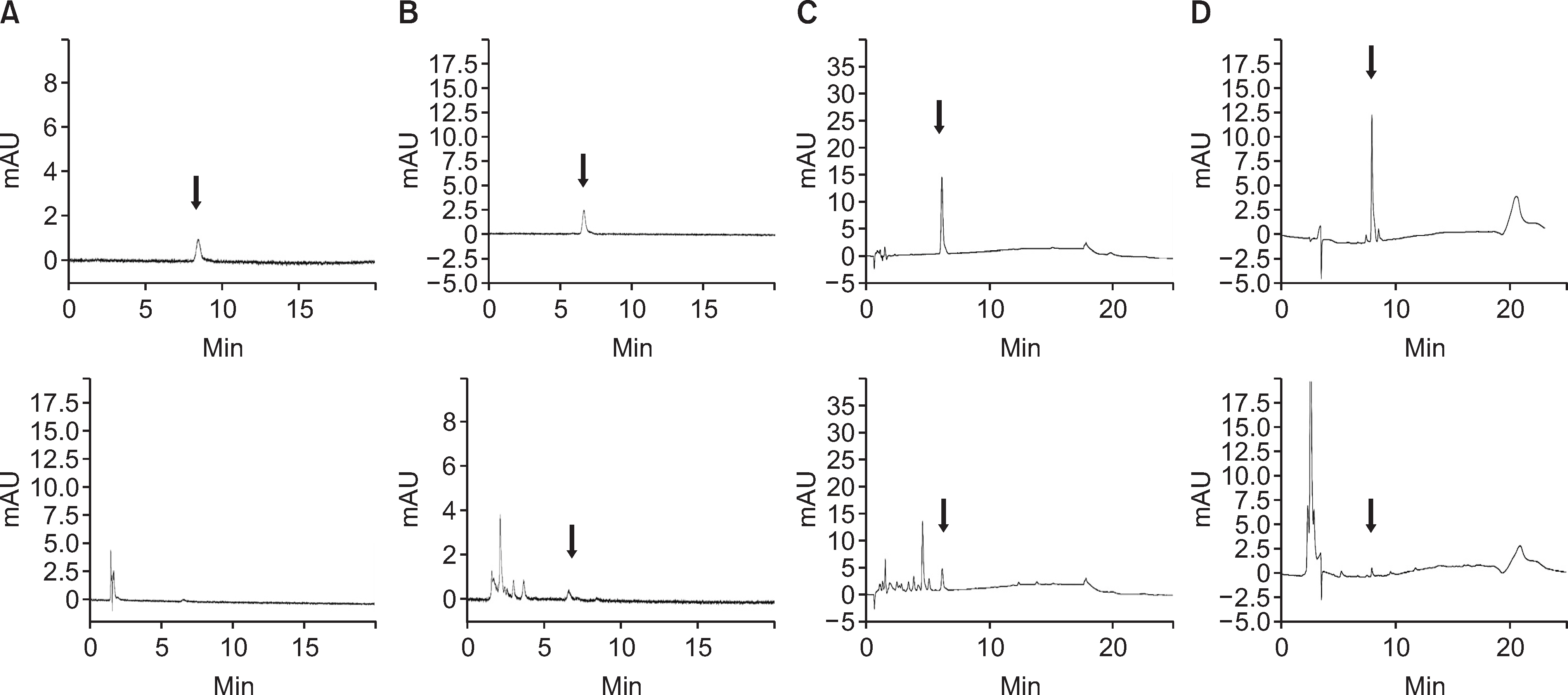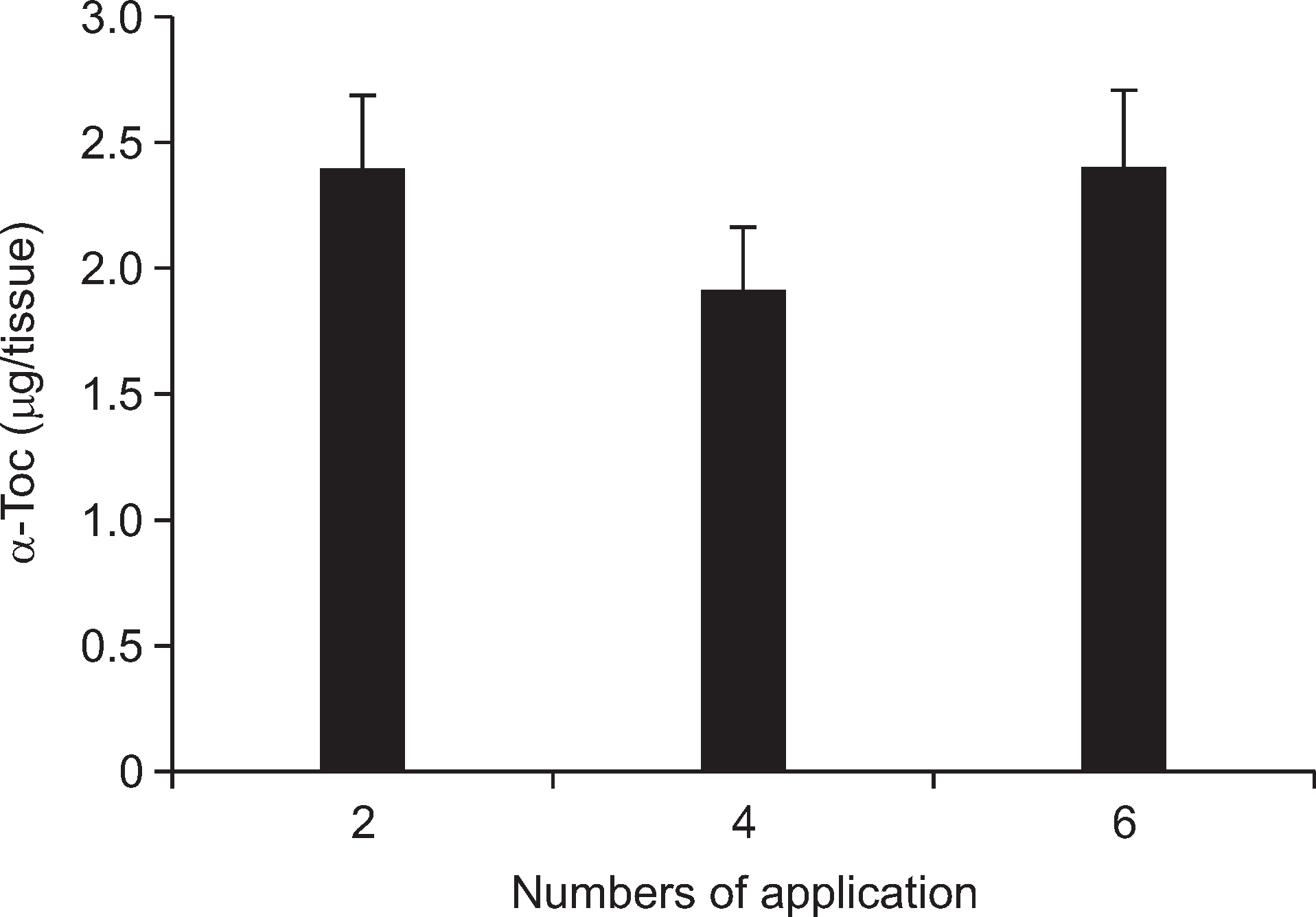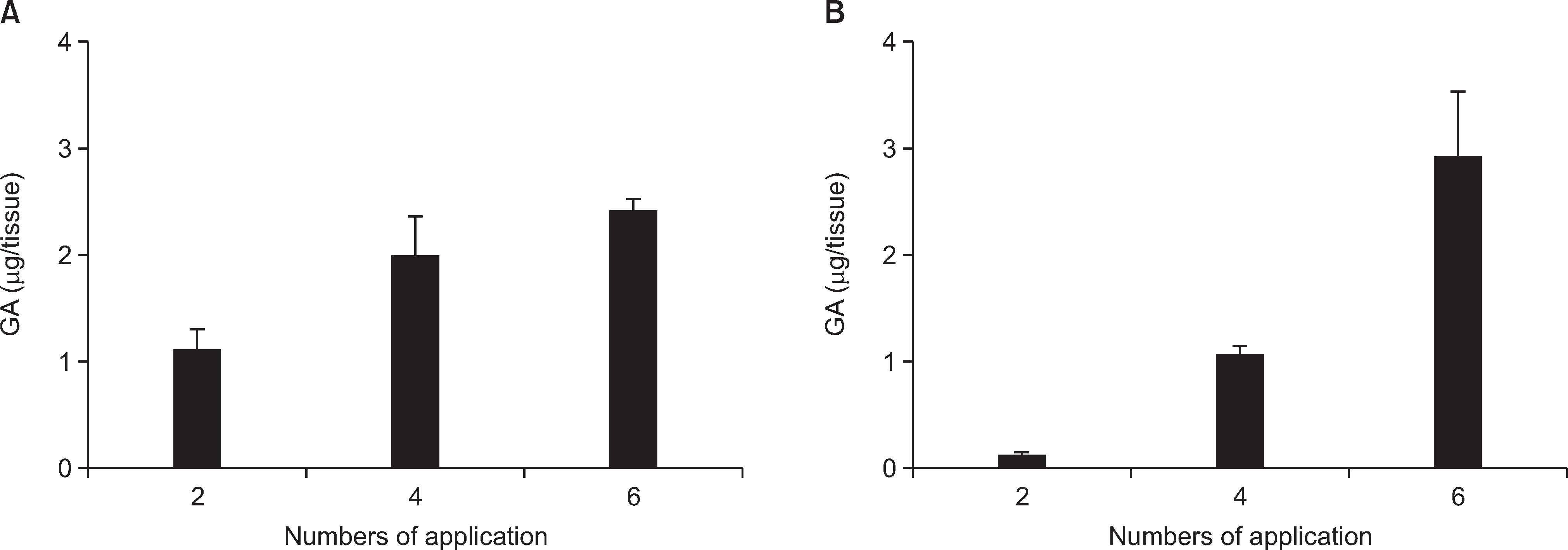J Korean Acad Oral Health.
2016 Jun;40(2):79-84. 10.11149/jkaoh.2016.40.2.79.
Gingival absorption of α-tocopherol acetate and 18β-glycyrrhetinic acid : in vitro evaluation in reconstructed gingival tissue
- Affiliations
-
- 1Research Park, LG Household & Healthcare Ltd., Daejeon, Korea. shleek@lgcare.com
- KMID: 2328811
- DOI: http://doi.org/10.11149/jkaoh.2016.40.2.79
Abstract
OBJECTIVES
To assess the absorption of α-tocopherol acetate and 18β-glycyrrhetinic acid, which are used as active ingredients in toothpaste, into a reconstructed gingival tissue.
METHODS
EpiGingival™ tissues were treated with a 25% slurry of toothpaste containing 2% α-tocopherol acetate and 0.3% 18β-glycyrrhetinic acid, for 2 minutes. The treatment was repeated up to 6 times, with 1 hour intervals. After completion of all treatments, the active ingredients in the tissue extracts and receiver solutions were measured by high performance liquid chromatography.
RESULTS
Although α-tocopherol acetate was not detected, α-tocopherol was detected in the tissue extracts, indicating that α-tocopherol acetate was bioconverted to α-tocopherol after absorption. We could detect 18β-glycyrrhetinic acid both in the tissue extracts and in the receiver solutions, with a positive correlation to the number of treatments.
CONCLUSIONS
We found that our toothpaste effectively delivered α-tocopherol acetate and 18β-glycyrrhetinic acid to a reconstructed gingival tissue in vitro.
Keyword
MeSH Terms
Figure
Reference
-
References
1. Kornman KS, Löe H. The role of local factors in the etiology of periodontal diseases. Periodontol 2000. 1993; 2:93–97.
Article2. Sbordone L, Bortolaia C. Oral microbial biofilms and plaque-related diseases: microbial communities and their role in the shift from oral health to disease. Clin Oral Investig. 2003; 7:181–188.
Article3. Taubman MA, Valverde P, Han X, Kawai T. Immune response: the key to bone resorption in periodontal disease. J Periodontol. 2005; 76:2033–2041.
Article4. Kornman KS, Crane A, Wang HY, di Giovine FS, Newman MG, Pirk FW, et al. The interleukin-1 genotype as a severity factor in adult periodontal disease. J Clin Periodontol. 1997; 24:72–77.
Article5. Waddington RJ, Moseley R, Embery G. Reactive oxygen species: a potential role in the pathogenesis of periodontal diseases. Oral Dis. 2000; 6:138–151.6. Derradjia A, Alanazi H, Park HJ, Djeribi R, Semlali A, Rouabhia M. a-tocopherol decreases interleukin-1b and -6 and increases human b-defensin-1 and -2 secretion in human gingival fibroblasts stimulated with Porphyromonas gingivalis lipopolysaccharide. J Periodontal Res. 2015; 27:Epub ahead of print.7. Cohen ME, Meyer DM. Effect of dietary vitamin E supplementation and rotational stress on alveolar bone loss in rice rats. Arch Oral Biol. 1993; 38:601–606.
Article8. Baljeet S, Shivani B, Rajesh G, Sachin G, Ram Rattan G. Antioxidants the new weapons in the fight against periodontal diseases. Dental Journal of Advance Studies. 2013; 1:85–90.9. Nizam N, Discioglu F, Saygun I, Bal V, Avcu F, Ozkan CK, et al. The effect of a-tocopherol and selenium on human gingival fibroblasts and periodontal ligament fibroblasts in vitro. J Periodonto. 2014; 85:636–644.10. Szuwart T, Brzoska T, Luger TA, Filler T, Peuker E, Dierichs R. Vitamin E reduces platelet adhesion to human endothelial cells in vitro. Am J Hematol. 2000; 65:1–4.
Article11. Calzada C, Bruckdorfer KR, Rice-Evans CA. The influence of anti-oxidant nutrients on platelet function in healthy volunteers. Atherosclerosis. 1997; 128:97–105.
Article12. Kim SR, Jeon HJ, Park HJ, Kim MK, Choi WS, Jang HO, et al. Glycyrrhetinic acid inhibits Porphyromonas gingivalis lipopolysaccharide-induced vascular permeability via the suppression of interleukin-8. Inflamm Res. 2013; 62:145–154.
Article13. Boisnic S, Ben Slama L, Branchet-Gumila MC, Watts M, d’Arros G. Anti-inflammatory effect of enoxolone in an ex-vivo human gingival mucosa model. Rev Stomatol Chir Maxillofac. 2010; 111:69–73.14. Salari MH, Kadkhoda Z. In vitro antibacterial effects of glycyrrhetinic acid on periodontopathogenic and capnophilic bacteria isolated from adult periodontitis. Clin Microbiol Infect. 2003; 9:987–988.
Article15. Mohammad HS, Nasralah S, Zainab K, Mohammad BK. Antibacterial effects of enoxolone on periodontopathogenic and capnophilic bacteria isolated from specimens of periodontitis patients. Iranian Biomedical Journal. 2003; 7:39–42.16. Sasaki H, Suzuki N, Alshwaimi E, Xu Y, Battaglino R, Morse L, et al. 18b-glycyrrhetinic acid inhibits periodontitis via glucocorticoid-independent nuclear factor-κB inactivation in interleukin-10-deficient mice. J Periodontal Res. 2010; 45:757–763.17. Moharamzadeh K, Franklin KL, Brook IM, van Noort R. Biologic assessment of antiseptic mouthwashes using a three-dimensional human oral mucosal model. J Periodontol. 2009; 80:769–775.
Article18. Yang J, Deol G, Myangar N. Retention of o-cymen-5-ol and zinc on reconstructed human gingival tissue from a toothpaste formulation. Int Dent J. 2011; 61:41–45.
Article19. Shim JY, Yim SB, Chung JH, Hong KS. Antiplaque and antigingivitis effects of a mouthrinse containing cetylpyridinium chloride, triclosan and dipotassium glycyrrhizinate. J Periodontal Implant Sci. 2012; 42:33–38.
Article20. Garcia N, Doucet O, Bayer M, Fouchard D, Zastrow L, Marty JP. Characterization of the barrier function in a reconstituted human epidermis cultivated in chemically defined medium. Int J Cosmet Sci. 2002; 24:25–34.
Article21. Mavon A, Raufast V, Redoulès D. Skin absorption and metabolism of a new vitamin E prodrug, delta-tocopherol-glucoside: in vitro evaluation in human skin models. J Control Release. 2004; 100:221–231.22. Shiratori T. Uptake, storage and excretion of chylomicra-bound 3H-alpha-tocopherol by the skin of the rat. Life Sci. 1974; 14:929–935.
- Full Text Links
- Actions
-
Cited
- CITED
-
- Close
- Share
- Similar articles
-
- Inhibitory effect of 18β-glycyrrhetinic acid on the biofilm formation of Streptococcus mutans
- Effect of glycyrrhetinic acid on the viability of human gingival fibroblasts
- A Case of Idiopathic Gingival Fibromatosis and Hypertrichosis
- A clinical study of the effects of orthodontic appliances on the gingival tissue
- Laterally positioned flap using subepithelial connective tissue graft for iatrogenic gingival recession treatment





